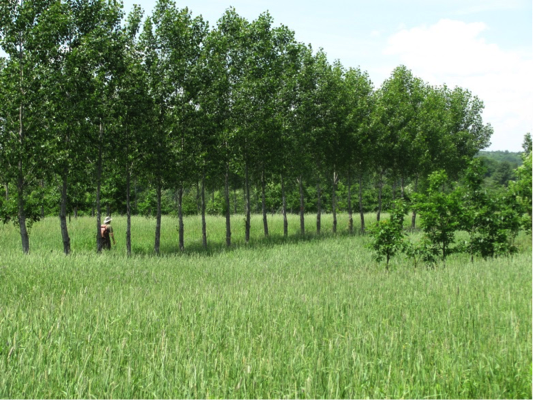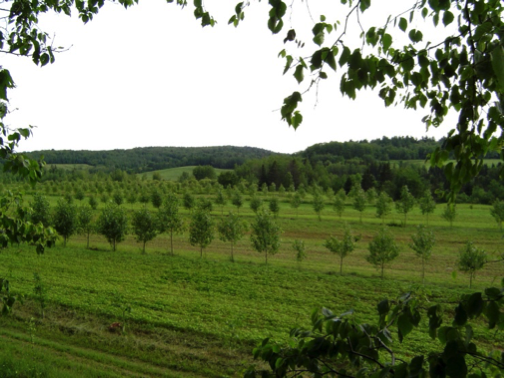Climate change is expected to affect crop yields in Quebec. A project underway at Laval University has been studying the impacts of tree-based intercropping on biodiversity, hydrology, microclimate and root distribution, as well as yield and profitability, as a way of adapting to climate change.
The research sites include different crops growing between rows of hybrid poplar or red oak. Over two years, the research group measured crop biomass, tree growth, root distribution, light, soil biochemistry, microbial resilience, density of soil microarthropods, and soil water content. The value of ecosystem services was also quantified, and an agroforestry model simulating these systems for different climatic scenarios was calibrated.
Root pattern was different between the two tree species with the shallower and more extensive poplar roots being more competitive with crops than those of red oak. However, light was found to be more important to crop yield. Thus, managing tree density and shape could help control light competition. Furthermore, a meta-analysis showed that the right tree species could be a key factor to climate change adaptation.

The density of soil microarthropods was greater under red oak than poplar. Tree-based intercropping, under increased drought, as predicted with climate change, may result in more organic resources for these organisms.
Although conventional agricultural systems gave better crop yields than tree-based intercropping because of tree-crop competition, the total relative productivity of trees and crops was greater in the agroforestry system with a land equivalent ratio (LER) higher than 1. Moreover, the total economic value of tree-based intercropping systems was 2.4 times higher when the value of ecosystem processes such as soil stabilization, carbon sequestration and pollination, were considered.
Simulations using the model predicted that tree-based intercropping would increase the LER under the climate change scenarios, since the productivity gains of trees would compensate for the reduced crop yield which would be much more stable in agroforestry systems.
Thus, the widespread adoption of tree-based intercropping in Quebec could help limit the need for risk management programs, generating savings for the public institutions that finance such programs.
Acknowledgements
Funding support from Consortium on Regional Climatology and Adaptation to Climate Change (OURANOS), through Fonds vert Québec, is gratefully acknowledged.

Selected papers
Alam, M., A. Olivier, A. Paquette J. Dupras, J.-P. Revéret, C. Messier. 2014. A general framework for the quantification and valuation of ecosystem services of tree-based intercropping systems. Agroforestry Systems 88: 679-691.
Bouttier L., A. Paquette, C. Messier, D. Rivest, A. Olivier, A. Cogliastro. 2014. Vertical root separation and light interception in a tree-based intercropping system of Eastern Canada. Agroforestry Systems 88: 693-706.
Hallema, D.W., A.N. Rousseau, S.J. Gumiere, Y. Périard, P.H. Hiemstra, L. Bouttier, M. Fossey, A. Paquette, A. Cogliastro, A. Olivier. 2014. Framework for studying the hydrological impact of climate change in an alley cropping system. Journal of Hydrology 517: 547-556.
Rivest, D., M. Lorente, A. Olivier, C. Messier. 2013. Soil biochemical properties and microbial resilience in agroforestry systems: effects on wheat growth under controlled drought and flooding conditions. Science of the Total Environment 463-464: 51-60.


